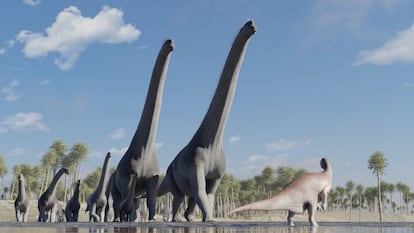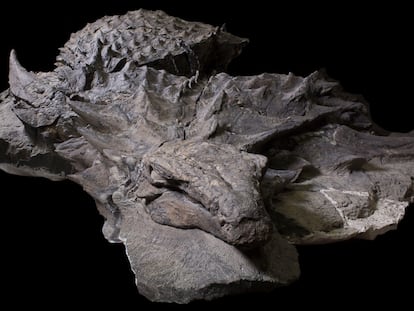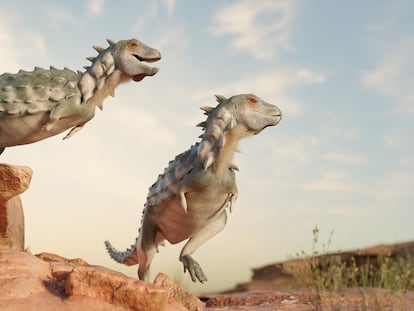A 150-million-year-old ‘dinosaur daycare’ is discovered in Bolivia at a site that is at risk of collapsing
Some 350 footprints found in the Andean country support the idea that adult sauropods cared for the entire herd’s offspring. The discovery also reveals the South American nation’s difficulties in protecting its paleontological heritage

Evo Morales’s government wasn’t the only thing that collapsed in Bolivia in 2019. At the time, a torrential spring rain crumbled part of the ravines of a river, exposing some 350 dinosaur footprints in the department of Tarija, in the south of the Andean country. Recently published research reveals “an authentic dinosaur daycare,” as one of the study’s authors, Argentine paleontologist Sebastián Apesteguía, describes it. Apesteguía, along with the rest of the scientists involved in the discovery, calls for adequate protection and conservation of the footprints, which are outdoors and at risk of disappearing due to new landslides.
The discovery reflects the scene of two adult sauropods (dinosaurs of the brontosaurus type) leading hundreds of young during the Upper Jurassic period, about 150 million years ago, at the height of the dinosaurs’ splendor. In addition, two ornithopods (specifically, iguanodonts) and a theropod (of the tyrannosaur type) obliquely and calmly pass each other along a path that, according to some paleontologists, was part of the world’s longest dinosaur migration route: in terms of today’s geography, the path went from southern Peru, through central Bolivia to northern Argentina.
But the relevance of this discovery is related to the culmination of another temporary journey. Until now, the Andean highland country only had records from the beginning and end of the era of these giant reptiles. “With this [new discovery], Bolivia now has a site with dinosaur footprints from the three periods: Triassic, Jurassic and Cretaceous,” says Apesteguía on a video call in which Bolivian geologist Gustavo Méndez Torres and Spanish ichnologist Raúl Esperante also participated. Méndez Torres, the article’s lead author and the one who discovered the footprints, recalls the moment of the discovery: “I felt great excitement wash over me… even more so, knowing that I was the [one who found] the only site with footprints from the Jurassic period in Bolivia.”
The article describes the footprints of the adult sauropods as “rounded, elephant-like, and between 75 and 95 centimeters in diameter.” Based on this data, the authors calculated that their hips would be almost four meters (13 feet) above the ground, their bodies would be about 20 meters (about 66 feet) long from nose to tail, and they would have had a heavy gait of less than five kilometers (about 3 miles) per hour. On the other hand, the tracks of the young dinosaurs measure between 15 and 30 centimeters in diameter. In a press release, the researchers emphasize that “the curious thing is that no more of these small footprints are seen at the site, which clearly indicates that they came along the same path or in a compact group with the two giant [dinosaurs], demonstrating herd behavior and protection of the young.”
Although the researchers warn that there is no absolute guarantee that these sauropods traveled in a herd, the scholars explain why they believe that this was the case. “The simplest thing is to think that they went together. In addition, we compared [the footprints] with current models, what we call autoecology: nowadays, we see elephants and other large vertebrates accompanied by their young, beside or behind [them]; and then we deduced by comparison,” Esperante says.

Another detail reinforces that thesis. “If the young had passed… an hour later or the next day, we would expect them to step on the adults’ footprints; but what we see is little to no overlap between the footprints,” Esperante explains. The overlap would have been more likely if they had walked at different times. But the footprints of the young do not go over those of the adults; they are to the side of them. There is a compelling reason: “The big ones left their paw marks, but the huge animal’s tail still had to pass through; so the little ones couldn’t walk there, they had to move over to one side,” says Apesteguía, who is affiliated with Argentina’s National Scientific and Technical Research Council (CONICET).
When reviewing the details that allow them to approach the giant animals’ intangible behavior, Esperante lets his enthusiasm shine through. “This site is amazing. It is spectacular. You have to go and see it,” he recommends. Then Apesteguía qualifies that statement, irrevocably changing the rest of the conversation: “Before it collapses.”
Collapsing in on prehistoric treasures
The problems that the paleontologist Esperante overcame to reach the site paled in comparison to the complexities that affect valuable sites such as Tarija. “I just traveled the week of the fall of Evo Morales, in 2019. Cochabamba was paralyzed, the whole country, but somehow I managed to fly to Tarija,” he recalls.
In the midst of that political crisis, the protection of the fossil record was not a priority and four years later it continues to be a challenge. “One of the big problems in Bolivia, as in many places, is how to protect these deposits, which are generally very inclined,” explains Apesteguía. Less than 500 kilometers from Tarija is the Cal Orcko national paleontological monument, the most important site with dinosaur footprints in the world, with thousands of footprints of multiple species scattered in ravines with a 70-degree inclination. “With anything that happens above, the collapse comes, and in Tarija the same. It looks like a jungle step that collapsed and that anticipates what the next one will be,” describes the Argentine paleontologist while begging for an urgent solution.
“Protecting the footprints by building an entire structure in the river basin is impossible. They won’t be able to do that and it doesn’t make sense. What [must] be done is a scan of the fingerprints now,” demands Apesteguía, in reference to the survey by photogrammetry: a high-precision measurement through aerial and satellite images, which allow images to be digitized and preserved in maximum detail.
Scientists emphasize the value of Tarija as a world heritage site. “It has been crucial in paleontology for a long time, since the 19th century. The most incredible megafauna fossils from Tarija, from the last million years, are in museums around the world, in prominent exhibitions,” highlights Apesteguía. What they describe begins to look like a modern version of plunder, but Esperante avoids that word: “I compare it to the exodus of Babylonian, Syrian, Egyptian archaeological material in the 19th century and early 20th century, mainly to Europe and to North America. When they did not have the record of care and preservation that those sites now have. This is equivalent.”
Méndez Torres adds that the lack of a scientific culture contributes to the management problem: “In places where there are finds from the Quaternary, people dance on the fossils because there are sectors where it is totally impossible to [move] without stepping on a record. Mastodons, glyptodonts, sloths and countless other specimens are totally neglected, even in places where there are signs warning of fines for taking fossils without authorization. With my own eyes, I saw the way an amateur picked up ten pieces, paid the fine and took them away. Unfortunately, there’s no interest here in Bolivia,” he complains.
Esperante blames the problem on the lack of a standardized protocol. “There is no official, routine, codified system for safeguarding and protecting fossils. Some people have the idea that it has to be preserved on site, but in two years there is nothing left. We need to educate different sectors [so they know] that conservation does not mean leaving it on site, if the site is not going to be preserved,” he warns.
Nature has proven him right. The Bolivian geologist gives his colleagues some bad news during the video call. In February 2020, in Tarija, “a rockslide caused by the rains washed away part of the site [that revealed the dinosaur nursery]. In the news, it came out that a landslide was blocking part of the road and when I saw it I immediately realized that it was the site of the footprints.” Regretfully, Méndez Torres recounts how he approached the site and spoke to local authorities, asking them to remove the blocks, “recover them and take them somewhere where they could be protected. But then the heavy machine operators loaded up the rubble, took it away and dumped it who knows where. Thus, more than 30 footprints were lost, which could have been exhibited in a museum,” Méndez Torres says sadly.
From plundering to protecting fossils
When seeking official answers about the conservation of this site of major paleontological importance, inquiries go back and forth between government agencies for days. At the Vice-Ministry of Science and Technology, which has been in the process of changing directors since July 27, we’re helped by a willing technical employee, who limits the competence of the division in which she works to promoting scientific research and refers the protection of paleontological heritage to the Ministry of Cultures. But according to their response, that ministry is not in charge of the subject either (despite the fact that the Bolivian Cultural Heritage Law, of 2014, indicates that it is). Instead, the authorities continue to pass the buck. For instance, the General Director of Cultural Heritage, Gonzalo Vargas, transfers the responsibility to the National Museum of Natural History, which depends on the Ministry of Environment and Water.
There, finally, the first and only formal responses are given by a small group of passionate geologists and biologists, who have more in the way of vocation than resources, and whose role in protecting fossils is limited to an advisory function. “The Ministry of Cultures didn’t know much about our role,” says biologist Hugo Araníbar, the director of the National Museum of Natural History. Through a series of seminars held on fossil trafficking over the last two years, they asked for his advice in specific cases, but in the case of the collapse of the Tarija footprints, no one informed them. “We have no documented knowledge of this issue,” states Araníbar. Bernandino Mamani Quispe, a geologist and the director of the museum’s Paleontology Unit, confirms that statement and explains that if the Tarija authorities (or authorities higher up) do not request their intervention, they are not authorized to intervene.
Araníbar confirms the lack of a standardized protocol, as pointed out by paleontologist Esperante. The pending regulation would also serve to reinforce the fight against the trafficking and plunder of fossils that began almost 30 years ago. Until the mid-1990s, “renowned [foreign] researchers used to come and ignore national regulations. They would come in, investigate and leave with the fossils,” says the biologist. “Ideally, the originals should be here so that other researchers can use them for their studies,” Araníbar says. According to his geologist colleague, the theft of fossils is not a problem that is exclusive to Bolivia; it is something that affects Latin America in general. They point to an emblematic case “of this indirect colonization that still persists”: the Brazilian fossil Ubirajara jubatus, which was recently returned from Germany following its appropriation in 1995.
The museum director explains that in order to keep the fossils in the sites where they were found, local, governmental or indigenous authorities must reach an agreement with the scientists. “But to do that, they must create the elements that allow for effective safeguarding.” When that is guaranteed, according to Araníbar, they can be returned to the appropriate place. “That is why it is important to strengthen local capacities,” he adds.
In this sense, Mamani Quispe regrets that Bolivia only has three universities that offer a degree in geology, and that paleontology occupies only two semesters in the curriculum. “The problem is so complex that we have to look at it from different angles. Those of us who are working in paleontology are essentially [idealists], we love the work. If I worked in oil or mining, I would earn four or five times what I earn here. Imagine: for a young person with aspirations, it is not attractive,” explains the geologist. He adds that there is a lack of government support for basic research because, he says, this type of science is not seen as having an immediate productive return.
However, they strive to create possibilities for the conservation of fossils: “We are at the stage of producing new documents, norms and regulations that can standardize the work at a national level. We are still working,” says Mamani Quispe. In spite of everything, his small group of dreamers, continues to resist at the National Museum of Natural History of Bolivia and propose steps forward.
Sign up for our weekly newsletter to get more English-language news coverage from EL PAÍS USA Edition
Tu suscripción se está usando en otro dispositivo
¿Quieres añadir otro usuario a tu suscripción?
Si continúas leyendo en este dispositivo, no se podrá leer en el otro.
FlechaTu suscripción se está usando en otro dispositivo y solo puedes acceder a EL PAÍS desde un dispositivo a la vez.
Si quieres compartir tu cuenta, cambia tu suscripción a la modalidad Premium, así podrás añadir otro usuario. Cada uno accederá con su propia cuenta de email, lo que os permitirá personalizar vuestra experiencia en EL PAÍS.
¿Tienes una suscripción de empresa? Accede aquí para contratar más cuentas.
En el caso de no saber quién está usando tu cuenta, te recomendamos cambiar tu contraseña aquí.
Si decides continuar compartiendo tu cuenta, este mensaje se mostrará en tu dispositivo y en el de la otra persona que está usando tu cuenta de forma indefinida, afectando a tu experiencia de lectura. Puedes consultar aquí los términos y condiciones de la suscripción digital.
More information

The strange case of the mummified dinosaurs

The strange, armored dinosaurs that once populated South America
Archived In
Últimas noticias
Welcome to the post-religion era: The idea of Christianity as the absolute truth has become obsolete
‘I thought you would like it’: The risky sexual practice popularized by TV shows and TikTok
The digitalization of tourism: ‘They promise experiences and gave us the worst possible one’
Mexican peso defies uncertainty with forecasts of a new period of stability in 2026
Most viewed
- Sinaloa Cartel war is taking its toll on Los Chapitos
- Reinhard Genzel, Nobel laureate in physics: ‘One-minute videos will never give you the truth’
- Oona Chaplin: ‘I told James Cameron that I was living in a treehouse and starting a permaculture project with a friend’
- Why the price of coffee has skyrocketed: from Brazilian plantations to specialty coffee houses
- Silver prices are going crazy: This is what’s fueling the rally









































